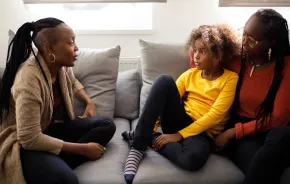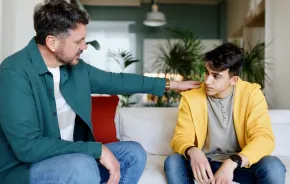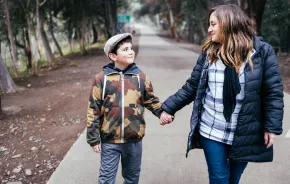Five-year-old Sally snuggles as her mom begins to read her a story. Both parent and child cherish the moment of togetherness. But while Sally may be sitting quietly, her brain is very busy--sorting, categorizing, guessing, analyzing and synthesizing, exploring and assessing a wide range of information, character traits and emotions.
Reading aloud can seem like magic--and research has shown its benefits. Children up to age 14 who regularly listen to stories for 20-30 minutes at a time are more likely to be successful in school, to be creative problem solvers, self-confident writers and speakers, and lifelong readers.
While the benefits of reading to children are well established, did you know that with a little guidance, children can get similar benefits from watching television? According to children's television researcher , Dr. Edward Palmer, watching television is "a remarkable intellectual act. All the while kids are watching, they are making hypotheses, anticipating, generalizing, remembering and actively relating what they see to their own lives."
While TV viewing should never replace reading to children, parents can make TV time more productive and educational. By asking the same questions they ask when reading aloud, parents can help children develop mental skills that will help them in school and for the rest of their lives. Below are seven simple techniques you can use as you watch TV with your family.
1. Make predictions. Kids love guessing games and their brains are primed for the mental activity needed to figure out possible answers. So before watching a program, look to see what it will be about and ask your child to make predictions about plot and action. Over time, you will notice your child's answers getting more sophisticated.
2. Help children concentrate and sustain attention. With preschoolers, suggest looking for the arrival of a favorite character or listening for a favorite song. With elementary-school children, help them focus on the content of the show and how it is made. For instance, ask them, "Do think they'll tell us what whales eat?" or say, "I wonder if the person holding the camera got wet when the whale jumped."
3. Retell the story. Just as you might ask a child what a book is about, do the same after a favorite TV program. This simple question shows interest in your child, and is a reliable way to help with many thinking skills, including sequencing events and recalling details. Let your child say as much as he or she remembers. Do keep asking, "Is there anything else?" until your child completes retelling the story. Prompt children to explain who did what, or how a character felt.
4. Discuss moods and emotions. Young children may have a hard time connecting a character's inner motives and outward actions. When a young child is watching Babar, for instance, you can point out how Babar might feel at a certain point in the story. Then you can link actions with feelings by asking such questions as, "When Babar was upset, what did he do?" With elementary kids, have them make a list of emotions--love, compassion, anger, etc.--on a piece of paper, before they watch a program. While watching, they can write the name of a character on the show who is expressing that particular emotion. When the program ends, talk about the results.
5. Point out context clues. Context clues help children understand what they read. For example, a child learning to read looks for context clues in the illustrations to help understand the text. If the boy in the picture is frowning, that shows what the word "scowl" means. Children can also find visual context clues in TV shows, which will lead them to higher-level thinking as they watch. For children younger than 8, point out: when a movie or TV program begins (with title and theme music), when a movie or TV program ends (with credits), predictable actions or mannerisms of favorite characters (Winnie the Pooh likes honey). With older elementary or middle-school children, discuss: body language that cues the viewer to anticipate identifiable behaviors (clenched fists can indicate anger or frustration), basic cues in celebrity-endorsement commercials (special effects that convey a celebrity's "star power"), news anchor's body language and mannerisms that bias reporting (facial expressions, tone of voice and comments that seem out of place in relation to the topic at hand).
6. Focus on personal relevance. A good book holds children's attention because it is personally meaningful to them. Children have favorite programs for the same reason. Does your daughter want to be smart and brave like Madeline--or pilot an airplane like Amelia Earhart? By simply asking children why they like a program, or what they liked best about something they just watched, you can help them make a personal connection to programs and develop interests.
7. Lead from your own curiosity. When you choose television programs with educational potential, encourage your kids with statements like: "I didn't know that, did you?" "What do you think of that?" Programs that are book-based give parents ways to tie in reading along with viewing. Also, for 7- to 12-year-olds, programs featuring biographies or historical figures lead naturally to reading about these individuals.
As you try out these TV-viewing strategies adapted from reading aloud, think of television as a "visual book." And like a good book, the home screen is rife with possibilities for enriching your child's language and thinking abilities. So snuggle up and... have fun!
Reprinted with permission of the author. Gloria DeGaetano of Bellevue has written a number of books on media literacy and is founder of the Parent Coaching Institute. Her latest book is "Parenting Well in a Media Age." For more information, visit www.ParentCoachingInstitute.com. To comment on this story or suggest a story idea, contact editor@ParentMap.com









